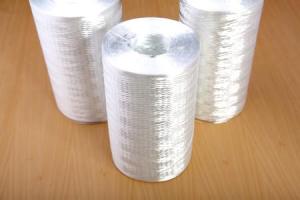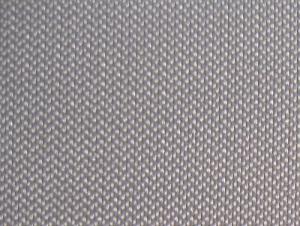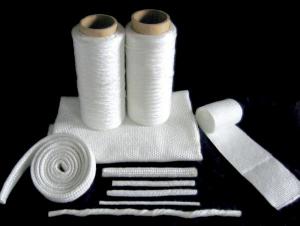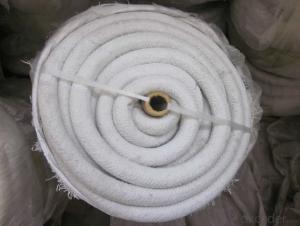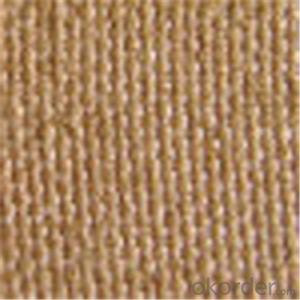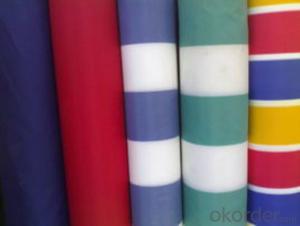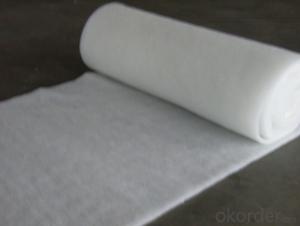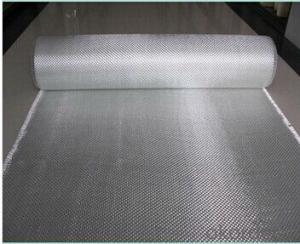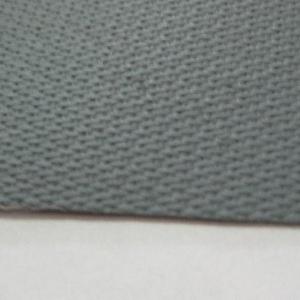Textured Fiberglass Yarn
- Loading Port:
- China Main Port
- Payment Terms:
- TT or L/C
- Min Order Qty:
- 10 Tons kg
- Supply Capability:
- 2*20FCL Per Month kg/month
OKorder Service Pledge
OKorder Financial Service
You Might Also Like
General Information of Textured Fiberglass Yarn
CMAX textured fiberglass textiles are made from textured E-glass fiber yarn which features bulky and resilient with high thermal insulation property. Diversified forms are available such as yarn, cloth, tape, rope, sleeving, etc.
Application of Textured Fiberglass Yarn
Textured fiberglass textiles are cost effective products used at high temperature up to 550º C. It exhibits properties of low thermal conductivity, electricity insulation and corrosive resistance.
Textured fiberglass textiles can be performed in process industries as fire curtains, gaskets or sealing in kiln, furnace or heaters etc. Application has been extended to the building industry as reinforcement material.
Chemical Analysis
SiO2: 54.1%
Al2O3: 14.6%
CaO: 16.6%
MgO: 4.6%
B2O3: 8.8%
Na2O+K2O: ≤ 0.8%
Fe2O3:<0.5%

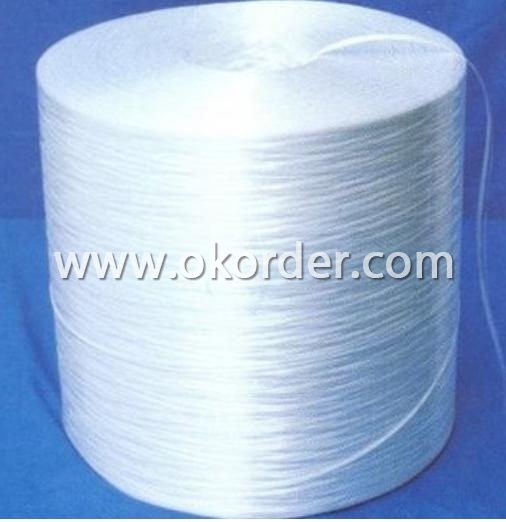
- Q:What are the different additives used in glass fiber textiles?
- There are several additives used in glass fiber textiles, including sizing agents, lubricants, coupling agents, and flame retardants. Sizing agents are used to improve the wetting and processing of the fibers, while lubricants reduce friction and improve the handling of the textiles. Coupling agents enhance the adhesion between the glass fibers and the matrix material. Flame retardants are also commonly added to glass fiber textiles to improve their fire resistance properties.
- Q:How do glass fiber textiles contribute to UV resistance?
- Glass fiber textiles contribute to UV resistance because they are made from glass fibers which have inherent UV-blocking properties. These fibers are able to absorb and reflect a significant amount of the UV radiation, thus reducing the amount of harmful UV rays that pass through the textile. This helps to protect the underlying materials, such as furniture or other objects, from UV damage and degradation.
- Q:How do glass fiber textiles perform in terms of flexibility?
- Glass fiber textiles possess exceptional flexibility, a quality attributed to the thin and lightweight nature of glass fibers. As a result, these textiles can be easily manipulated through bending, twisting, or folding, all while maintaining their original form and structural integrity. This remarkable flexibility allows for their wide range of applications and adaptability. They can seamlessly integrate into composite materials, like laminates, to enhance both flexibility and mechanical properties. Moreover, glass fiber textiles exhibit remarkable resilience, enabling them to endure repeated bending or stretching without fracturing or losing their original shape. This outstanding feature makes them highly suitable for industries that prioritize flexibility, such as aerospace, automotive, and sports. In summary, glass fiber textiles provide a superior level of flexibility, making them the favored choice for numerous applications.
- Q:Are glass fiber textiles suitable for automotive interiors?
- Glass fiber textiles are a great choice for automotive interiors due to their many advantages. Firstly, they are highly durable and resistant to wear and tear, making them perfect for the automotive industry. They can withstand everyday use and exposure to sunlight, moisture, and temperature changes without losing their shape or strength. Secondly, glass fiber textiles provide excellent heat and sound insulation. They effectively reduce the transmission of heat and noise, resulting in a more comfortable driving experience. This is especially important in automotive interiors where reducing noise levels and maintaining a comfortable temperature are crucial. Additionally, glass fiber textiles are lightweight, which is a key factor in the automotive industry. By using them in automotive interiors, the overall weight of the vehicle can be reduced, leading to improved fuel efficiency and lower emissions. Moreover, their lightweight nature allows for easier installation and customization of automotive interiors. Furthermore, glass fiber textiles offer design flexibility. They can be molded into various shapes and patterns, allowing for unique and creative interior designs. This enables automotive manufacturers to create visually appealing interiors that enhance the overall look and feel of the vehicle. Lastly, glass fiber textiles are easy to clean and maintain. They are resistant to stains and can be easily wiped clean, making them perfect for automotive interiors that are often exposed to spills and dirt. In conclusion, glass fiber textiles are an excellent choice for automotive interiors. Their durability, heat and sound insulation properties, lightweight nature, design flexibility, and ease of maintenance make them ideal for creating high-quality, comfortable, and visually appealing interiors in vehicles.
- Q:Can glass fiber textiles be used for making upholstery?
- Yes, glass fiber textiles can be used for making upholstery. Glass fiber textiles are known for their durability, strength, and fire resistance properties. These textiles are commonly used in industries such as automotive, aerospace, and marine where high-performance materials are required. When used for upholstery, glass fiber textiles provide excellent resistance to wear and tear, making them suitable for high-traffic areas. Moreover, glass fiber textiles are also resistant to moisture, mold, and mildew, making them ideal for upholstery applications in humid environments. Additionally, glass fiber textiles can be easily woven into different patterns and designs, allowing for versatility in upholstery applications. However, it is important to note that glass fiber textiles may not be as soft or comfortable as other materials commonly used for upholstery, such as fabric or leather.
- Q:How do glass fiber textiles compare to carbon fiber textiles in terms of strength?
- Glass fiber textiles and carbon fiber textiles have different properties and strengths, making them suitable for different applications. In terms of strength, carbon fiber textiles generally outperform glass fiber textiles. Carbon fiber textiles have an exceptionally high tensile strength, which means they can withstand pulling forces without breaking or deforming. They are known to be significantly stronger than most other materials, including glass fiber textiles. This high strength-to-weight ratio makes carbon fiber textiles ideal for applications that require lightweight yet strong materials, such as aerospace, automotive, and sporting goods industries. On the other hand, glass fiber textiles have a relatively lower tensile strength compared to carbon fiber textiles. However, they still possess considerable strength and are commonly used in various industries, including construction, boat-building, and electrical insulation. Glass fiber textiles are also more affordable than carbon fiber textiles, making them a popular choice for applications where high strength is not the primary requirement. In summary, while both glass fiber textiles and carbon fiber textiles have their own strengths, carbon fiber textiles generally offer superior strength compared to glass fiber textiles. However, the choice between the two depends on the specific application and the desired balance of strength, weight, and cost.
- Q:Why is the strength of glass fiber cloth 45 degrees direction low?
- The tensile strength of the glass fabric must be low in relation to the tensile strength at 45 degreesHowever, depending on where you are testing, the position of the fixture is usually in the direction of 0 degrees or 90 degrees
- Q:How do glass fiber textiles affect the drapability of fabrics?
- Glass fiber textiles, also known as fiberglass textiles, can significantly affect the drapability of fabrics. The addition of glass fibers to a fabric can enhance its stiffness and rigidity, making it less likely to drape naturally. This is because glass fibers have a high tensile strength and are relatively inflexible compared to natural or synthetic fibers commonly used in textiles. When glass fiber textiles are incorporated into fabrics, they create a network of interlocking fibers that add structure and stability to the material. This can be desirable in certain applications where a more rigid fabric is desired, such as in industrial or technical textiles. However, in garments or home furnishings where drape and fluidity are important, the presence of glass fibers can be a disadvantage. The stiffness imparted by glass fiber textiles can restrict the movement and flow of the fabric, leading to a less natural drape. Fabrics with glass fibers may not hang as smoothly or gracefully as those without, and may appear more stiff and rigid when worn or used in drapery. Additionally, the presence of glass fibers can affect the feel and texture of the fabric, making it potentially less comfortable against the skin. It is worth noting that the extent to which glass fiber textiles affect drapability can vary depending on the concentration and distribution of the fibers within the fabric. Higher concentrations of glass fibers or a more densely woven or knitted structure will generally result in a more pronounced impact on drapability. Overall, while glass fiber textiles can offer certain benefits in terms of strength and stability, they can have a negative impact on the drapability of fabrics. It is important for designers and manufacturers to consider the intended application and desired characteristics of a fabric when deciding whether to incorporate glass fibers or opt for other alternatives.
- Q:How do glass fiber textiles perform in terms of breathability in footwear?
- Glass fiber textiles can vary in terms of breathability when used in footwear. Generally, glass fiber textiles have good moisture-wicking properties, meaning they can effectively draw sweat away from the foot and keep it dry. This is beneficial for maintaining a comfortable foot environment and reducing the chance of foot odor or fungal infections. However, glass fiber textiles are not as breathable as natural fibers like cotton or linen. They do not have the same level of air permeability, which can limit the airflow within the footwear. This can result in a slightly less breathable environment for the foot, especially in warm or humid conditions. Nonetheless, manufacturers often combine glass fiber textiles with other materials in footwear to enhance breathability. For example, they may use mesh panels or perforations in conjunction with glass fiber textiles to improve air circulation and ventilation. Additionally, technologies like moisture-wicking linings or specialized coatings can further enhance breathability in footwear that incorporates glass fiber textiles. Ultimately, the breathability of glass fiber textiles in footwear will depend on several factors, including the specific construction of the footwear, the design features, and the overall materials used. It is always recommended to consider the intended use and climate conditions when selecting footwear with glass fiber textiles to ensure optimal breathability and comfort.
- Q:Can glass fiber textile be used in acoustic panels?
- Acoustic panels can indeed utilize glass fiber textile. Thanks to its porous structure, glass fiber textiles, like fiberglass cloth, possess exceptional sound absorption properties. By incorporating glass fiber textile into acoustic panels, the material is able to effectively absorb sound waves, thereby reducing sound reflection and reverberation. Consequently, this enhances the overall acoustics of the room. Furthermore, glass fiber textiles are lightweight, durable, and fire-resistant, rendering them suitable for use in acoustic panels. They are easily installed and come in various thicknesses and densities, allowing for customization to meet specific acoustic requirements. Due to their versatility and excellent sound absorption capabilities, glass fiber textiles have become a popular choice for acoustic panels.
1. Manufacturer Overview |
|
|---|---|
| Location | |
| Year Established | |
| Annual Output Value | |
| Main Markets | |
| Company Certifications | |
2. Manufacturer Certificates |
|
|---|---|
| a) Certification Name | |
| Range | |
| Reference | |
| Validity Period | |
3. Manufacturer Capability |
|
|---|---|
| a)Trade Capacity | |
| Nearest Port | |
| Export Percentage | |
| No.of Employees in Trade Department | |
| Language Spoken: | |
| b)Factory Information | |
| Factory Size: | |
| No. of Production Lines | |
| Contract Manufacturing | |
| Product Price Range | |
Send your message to us
Textured Fiberglass Yarn
- Loading Port:
- China Main Port
- Payment Terms:
- TT or L/C
- Min Order Qty:
- 10 Tons kg
- Supply Capability:
- 2*20FCL Per Month kg/month
OKorder Service Pledge
OKorder Financial Service
Similar products
New products
Hot products
Hot Searches
Related keywords

